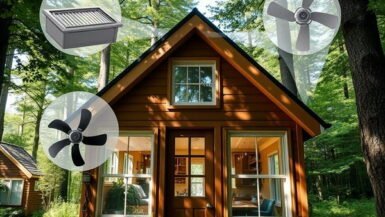With the growing interest in downsizing and living sustainably, tiny homes have rapidly gained popularity in recent years. One of the most crucial aspects of sustainable living is ensuring that your tiny home is equipped with an environmentally friendly energy source. In this article, we will delve into the world of solar panel systems, exploring the various factors you need to consider when choosing the right one for your tiny home. From understanding your energy needs to evaluating different panel types, installation options, and maintenance requirements, this comprehensive guide will provide you with the essential information to make an informed decision for a greener and more efficient tiny home. Embark on this eco-conscious journey with us, and discover the ideal solar panel system tailored to your tiny abode.
Determining Your Energy Needs: Calculating Daily Consumption
Before diving into the world of solar panel systems, it’s essential to first understand your tiny home’s energy needs. Knowing how much energy you consume daily will help you choose the right solar panel system that fits your lifestyle and requirements. In this subsection, we will walk you through the process of calculating your daily energy consumption and provide tips on how to reduce it to make your tiny home even more sustainable.
Creating an Energy Inventory
Start by making a list of all electrical appliances and devices you use in your tiny home. Be sure to include essential items such as lighting, heating and cooling systems, kitchen appliances, and electronics. Once you have your list, note the wattage of each item, which can usually be found on the product label or in the owner’s manual.
Calculating Daily Energy Consumption
To calculate your daily energy consumption, multiply the wattage of each item by the number of hours it operates per day. The result will give you the daily watt-hours (Wh) of each appliance. Add up the watt-hours of all your devices to determine your total daily energy consumption. For example, if you have a 60-watt light bulb that you use for four hours a day, its daily energy consumption would be 240 Wh (60 watts x 4 hours).
Accounting for Energy Efficiency
It’s crucial to consider energy efficiency when determining your energy needs. Investing in energy-efficient appliances and LED lighting can significantly reduce your daily consumption, making it easier to meet your energy needs with a solar panel system. Additionally, adopting energy-saving habits, such as turning off lights when not in use and unplugging devices when they’re not needed, can further decrease your energy consumption.
Estimating Your Solar Panel System Size
To estimate the size of the solar panel system you’ll need, divide your total daily energy consumption (in watt-hours) by the average daily sunlight hours in your area. This figure will give you the required solar panel capacity in watts. It’s essential to consider factors such as shading, weather conditions, and panel efficiency when sizing your system. It’s also a good idea to add a buffer of around 20% to account for potential energy needs in the future or during periods of high consumption.
By thoroughly assessing your energy needs and adopting sustainable habits, you can effectively determine the right solar panel system for your tiny home. With this information in hand, you’ll be well-equipped to make an informed decision and enjoy the numerous benefits of living off renewable energy.
Types of Solar Panels: Monocrystalline vs. Polycrystalline
When it comes to selecting the right solar panel system for your tiny home, one of the most important decisions you’ll make is choosing between monocrystalline and polycrystalline panels. Both types have their unique advantages and disadvantages, and understanding these differences is key to determining which option is best suited for your needs. In this subsection, we will explore the characteristics of monocrystalline and polycrystalline solar panels to help you make an informed decision.
Monocrystalline Solar Panels: High Efficiency and Sleek Aesthetics
Monocrystalline solar panels are made from a single crystal structure, which allows for a more efficient flow of electrons, resulting in higher energy output. These panels are known for their sleek, dark appearance and uniform color, making them an aesthetically pleasing option for those who value design.
Some key advantages of monocrystalline solar panels include:
– Higher efficiency: Monocrystalline panels typically have an efficiency rating of 15-20%, making them the more efficient option compared to their polycrystalline counterparts.
– Space-saving: Due to their higher efficiency, monocrystalline panels require less surface area to produce the same amount of energy, making them ideal for tiny homes with limited roof space.
– Longevity: Monocrystalline panels are known for their durability and can maintain their performance for 25 years or more.
However, monocrystalline solar panels tend to be more expensive than polycrystalline panels, which might be a concern for those with a tight budget.
Polycrystalline Solar Panels: Cost-Effective and Environmentally Friendly
Polycrystalline solar panels are made from multiple silicon crystal fragments, resulting in a lower efficiency rate compared to monocrystalline panels. They have a distinctive blue hue and a somewhat less uniform appearance. Despite their lower efficiency, polycrystalline panels are a popular choice for several reasons:
– Lower cost: Polycrystalline solar panels are generally less expensive than monocrystalline panels, making them an attractive option for those looking to save on initial costs.
– Environmentally friendly: The manufacturing process of polycrystalline panels produces less waste, contributing to a lower environmental impact.
– Improved performance in high heat: While both panel types experience reduced efficiency in high temperatures, polycrystalline panels tend to perform better in hot conditions.
The main drawback of polycrystalline panels is their lower efficiency, which may require more panels or a larger surface area to generate the same amount of energy as monocrystalline panels.
When choosing between monocrystalline and polycrystalline solar panels for your tiny home, consider factors such as your budget, available roof space, and personal aesthetic preferences. By carefully weighing the advantages and disadvantages of each panel type, you can select the solar panel system that best aligns with your sustainable living goals and lifestyle needs.
Off-Grid vs. Grid-Tied Solar Systems: Which is Best for Your Tiny Home?
When it comes to choosing the right solar panel system for your tiny home, another crucial decision you’ll need to make is whether to opt for an off-grid or grid-tied system. Both options come with their unique benefits and challenges, and understanding these differences will help you determine which system best suits your sustainable living goals and lifestyle needs. In this subsection, we will explore the pros and cons of off-grid and grid-tied solar systems to provide you with the necessary information to make an informed choice.
Off-Grid Solar Systems: Complete Energy Independence
An off-grid solar system is a stand-alone energy solution that operates independently of the traditional electrical grid. This type of system relies on solar panels, batteries, and often a backup generator to provide all the necessary energy for your tiny home. Some key advantages of off-grid solar systems include:
– Energy independence: With an off-grid system, you are entirely self-sufficient in terms of energy production, making you less vulnerable to power outages and fluctuations in energy prices.
– Remote living possibilities: Off-grid solar systems enable you to live in remote locations where connecting to the electrical grid may be impractical or impossible.
– Environmental benefits: By relying solely on renewable energy, off-grid systems contribute to a smaller carbon footprint and a more sustainable lifestyle.
However, off-grid systems can come with some challenges, such as:
– Higher upfront costs: Installing an off-grid solar system typically requires a more significant initial investment due to the need for batteries and additional components.
– Maintenance and monitoring: Off-grid systems may require more regular maintenance and monitoring to ensure optimal performance and prevent issues such as battery degradation.
– Limited energy availability: During periods of low sunlight or increased energy demand, off-grid systems may struggle to meet your energy needs, necessitating the use of a backup generator or energy conservation measures.
Grid-Tied Solar Systems: Connection and Convenience
A grid-tied solar system is connected to the traditional electrical grid, allowing you to draw power from the grid when your solar panels are not generating enough energy to meet your needs. Some key benefits of grid-tied solar systems include:
– Lower upfront costs: Grid-tied systems generally have lower initial costs, as they do not require the same level of battery storage or backup power sources as off-grid systems.
– Net metering: Many utility companies offer net metering programs, allowing you to feed excess solar energy back into the grid and receive credits on your utility bill.
– Reliability: With a grid-tied system, you can rely on the electrical grid to provide power during periods of low sunlight or increased energy demand, ensuring a consistent energy supply.
However, grid-tied solar systems also come with some drawbacks, such as:
– Dependence on the grid: With a grid-tied system, you remain reliant on the traditional electrical grid, making you susceptible to power outages and fluctuations in energy prices.
– Limited remote living possibilities: Grid-tied systems require a connection to the electrical grid, limiting your options for living in remote or off-the-beaten-path locations.
When choosing between an off-grid and grid-tied solar system for your tiny home, consider factors such as your desired level of energy independence, location preferences, and budget constraints. By carefully evaluating the advantages and disadvantages of each system type, you can select the solar panel system that aligns perfectly with your sustainable living vision and personal requirements.
Essential Components of an Efficient Solar Panel System
Designing an efficient solar panel system for your tiny home involves more than just selecting the right solar panels. There are several key components that work together to create a comprehensive, reliable, and efficient energy solution tailored to your specific needs. In this subsection, we will delve into the essential components of a solar panel system and discuss their roles in ensuring optimal performance and longevity. By understanding the functions of these crucial elements, you’ll be well-equipped to make informed decisions when designing the perfect solar panel system for your sustainable tiny home.
Charge Controllers: Guarding Your System’s Lifespan
A charge controller is a critical component that regulates the flow of electricity between the solar panels and the batteries. Its primary function is to protect your battery bank from overcharging and extend its lifespan. Charge controllers come in two main types: PWM (Pulse Width Modulation) and MPPT (Maximum Power Point Tracking). While PWM controllers are more affordable, MPPT controllers offer better efficiency and adaptability to varying sunlight conditions, making them a popular choice for tiny home solar panel systems. Whichever type you choose, a charge controller is a must-have component to ensure the longevity and efficiency of your system.
Batteries: Storing Your Solar Energy
Batteries play a crucial role in your solar panel system by storing the electricity generated by your panels for later use. Choosing the right battery type and capacity is essential for maintaining consistent power supply and meeting your energy needs during periods of low sunlight or increased consumption. There are several battery options available, including lead-acid, lithium-ion, and flow batteries. Each type has its advantages and drawbacks, so it’s essential to research and compare battery types to find the one that best suits your specific energy requirements and budget.
Inverters: Converting Solar Power to Usable Electricity
An inverter is responsible for converting the direct current (DC) electricity produced by your solar panels into alternating current (AC) electricity, which powers most household appliances and devices. There are two main types of inverters: string inverters and microinverters. String inverters are a cost-effective option that connects multiple solar panels in a series, while microinverters are installed on each individual panel, providing better efficiency and performance monitoring. Consider factors such as the size of your solar panel system, shading conditions, and budget when selecting the right inverter for your tiny home.
Mounting Systems: Securely Installing Your Solar Panels
Mounting systems provide the necessary support and structure to securely install your solar panels on your tiny home’s roof or a ground-based structure. There are various mounting options available, such as fixed mounts, adjustable mounts, and tracking systems. Fixed mounts are the most affordable option and require minimal maintenance, while adjustable mounts allow you to change the panel’s angle for optimal sunlight exposure. Tracking systems automatically follow the sun’s movement to maximize energy production but come at a higher cost and require more maintenance. When selecting a mounting system, consider factors such as your location, available space, and budget.
Understanding the roles and functions of these essential components will help you design an efficient and reliable solar panel system tailored to your tiny home’s specific needs. With a well-planned solar panel system in place, you can enjoy the numerous benefits of sustainable living, including reduced energy costs, a smaller carbon footprint, and a more eco-conscious lifestyle.
Maximizing Solar Efficiency: Tips for Proper Installation and Maintenance
Achieving optimal performance from your solar panel system is crucial to fully harnessing the potential of renewable energy for your tiny home. In this subsection, we will explore valuable tips and best practices for proper installation and maintenance of your solar panel system. By implementing these strategies, you can ensure that your system operates at peak efficiency, providing you with a reliable and sustainable source of energy for years to come.
Strategic Panel Placement for Maximum Sunlight Exposure
One of the most critical factors in maximizing your solar panel system’s efficiency is ensuring that your panels receive adequate sunlight throughout the day. Aim to install your panels in a location that offers minimal shading and maximum sun exposure. Additionally, consider the orientation and tilt angle of your panels to optimize their energy production. In the Northern Hemisphere, panels should generally face south, while those in the Southern Hemisphere should face north. The ideal tilt angle will vary based on your geographic location, so consult local solar experts to determine the best angle for your tiny home.
Optimal System Sizing for Your Energy Needs
As discussed earlier in this article, accurately assessing your daily energy consumption is vital in designing a solar panel system that meets your specific needs. Ensure that your system is neither undersized nor oversized, as both scenarios can lead to reduced efficiency and unnecessary expenses. Regularly reevaluate your energy consumption to account for any changes in your lifestyle or appliance usage, and adjust your system accordingly.
Regular Cleaning and Debris Removal
Dirt, dust, and debris can accumulate on your solar panels over time, reducing their efficiency and energy output. To maintain optimal performance, it’s essential to clean your panels regularly using water and a soft cloth or sponge. Avoid using abrasive materials or high-pressure water, as they can damage the panels. Additionally, remove any debris, such as leaves or branches, that may obstruct sunlight and negatively impact your system’s efficiency.
Periodic Inspections and Professional Maintenance
Regularly inspect your solar panel system for signs of wear or damage, such as loose connections, cracks in the panels, or corrosion. It’s also essential to monitor your system’s performance to identify any sudden drops in efficiency or energy production. Schedule professional maintenance at least once a year to ensure that all components, including the charge controller, batteries, and inverter, are functioning correctly and efficiently.
Investing in Energy-Efficient Appliances and Practices
While not directly related to your solar panel system, adopting energy-efficient appliances and habits can significantly impact your system’s overall efficiency. By reducing your daily energy consumption, you can decrease the strain on your solar panel system and ensure that it operates at peak performance. Consider investing in LED lighting, Energy Star-rated appliances, and smart home technologies to further enhance your tiny home’s sustainability and energy efficiency.
By following these tips and best practices for proper installation and maintenance, you can maximize the efficiency and longevity of your solar panel system. This proactive approach will not only provide you with a reliable source of renewable energy but also contribute to a more sustainable and eco-friendly lifestyle in your tiny home.





Leave a reply